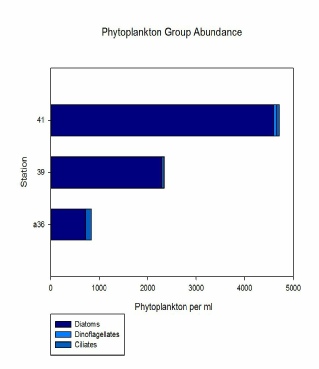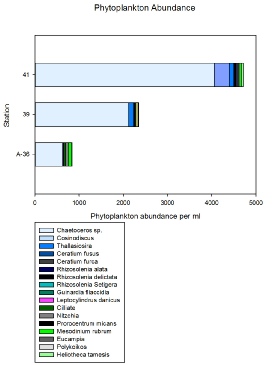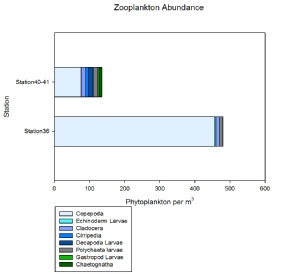
Falmouth 2015 -

Data analysed is only for the stations sampled by group 1 from the furthest point
up the estuary-
Abundance increases significantly further down the estuary. The diatom species Chaetoceros dominated at all 3 stations, accounting for 86% of the total phytoplankton sampled.
The increase in Chaetoceros sp. down the estuary may be due to its adaptation to brackish conditions and its high growth rates. Diatoms have a reference for higher salinity well mixed waters compared to dinoflagellates which favour stratified waters. (Martin, 1970). Chaetoceros is a siliceous diatom, (Rogerson, A, 1986), in figure 22 station 40/41 shows a subsurface silicon minimum around 7m and then an increase until maximum sampling depth. This may be due to recycling and resuspension of detritus of Chaetoceros and other siliceous diatoms.
The high levels of phytoplankton indicate that a bloom is occurring within the estuary,
stations 40 and 41 also had the highest chlorophyll levels of any station, over 5
ug/L at the surface, which co-
Station 36-
Station 39 had around half as many phytoplankton per ml as station 41. 11 different species were present of which Eucampia, Prorocentrum micans and ceratium furca were unique to station 39. Cilliates were 1.1% of the population, dinoflagellates were 1.3% and diatoms constituted 97.6%.
Station 41 had the largest number of species present, 12 out of 17 species identified through the estuary. Cosinodiscus, Rhizosolenia delictula, Rhizsolenia setigera, Guinardia fliaccida and Heliotheca tamesis were unique to station 41. Diatoms accounted for 97.6% of the population, dinoflagellates were 1% and ciliates accounted for 1.4%.
Zooplankton were sampled at stations 36 (A), (the first point in the estuary) and 40/41 (the mid point of the estuary). The most dominant zooplankton was Copepoda sp., which accounted for 86% of the population. 12 different species were identified.
Station 36 had more than double the abundance of station 40/41. 4 species of zooplankton were present and Echinoderm larvae were unique to the first station. Copepods where very dominant at this station constituting more than 95% of the population.
Station 40/41 was more biodiverse than station 36 with 7 species present and Chaetognatha, Gastropod larvae, Decapod larvae and Cirripedia being unique to this station. Copepoda also dominated at this station but constituted a lower percentage, 56% of the population.
Zooplankton abundance does not have a positive covariance with phytoplankton abundance. This may be due to a lag in predator prey relationship, if a bloom only recently occurred at station 40/41. Different species of zooplankton may also have different feeding patterns and rates than others.

Figure 30: Phytoplankton Abundance (Click to enlarge)
Figure 31: Phytoplankton group Abundance (Click to enlarge)

Figure 32: Zooplankton Abundance (Click to enlarge)
Disclaimer: The views expressed here are not associated with those of the National Oceanography Centre Southampton or the University of Southampton.
References
Rogerson, A., Defreitas, A.S.W, Mclnnes. A. G, ' Growth rates and ultrastructure
of siliceous setae of chaetoceros gracilis (bascillariophysceae) 2 Journal of phycology.
22. 1 (1986) 56-
Martin, J.V, ‘Salinity as a factor controlling the distribution of benthic estuarine diatoms’ Oregon state university, PhD thesis (1970)